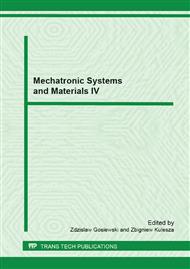[1]
K. Fujimura, H. Samet, A hierarchical strategy for path planning among moving obstacles, IEEE Trans. Robot. Automat., vol. 5, pp.61-69, (1989).
DOI: 10.1109/70.88018
Google Scholar
[2]
P. Fiorini, Z. Shiller, Motion planning in dynamic environments using velocity obstacles, International Journal of Robotic Research, vol. 17, no. 7., pp.760-772, (1998).
DOI: 10.1177/027836499801700706
Google Scholar
[3]
X. Xu, X. N. Wang, H.G. He, A self learning reactive navigation method for mobile robots, in Proceedings of the Second International Conference on Machine Learning and Cybernetics, Xian, pp.2384-2388, (2003).
DOI: 10.1109/icmlc.2003.1259909
Google Scholar
[4]
S. Věchet, V. Ondroušek, Motion planning of autonomous mobile robot in highly populated dynamic environment, in Mechatronics, recent technological and scientific advances, Springer, pp.453-462, (2011).
DOI: 10.1007/978-3-642-23244-2_55
Google Scholar
[5]
S. Věchet, The rule based path planner for autonomous mobile robot, 17th International Conference on Soft Computing MENDEL 2011, Brno, pp.546-551, (2011).
Google Scholar
[6]
J. Krejsa, S. Věchet, Mobile Robot Motion Planner via Neural Network, in Proceedings of Engineering Mechanics 2011, Svratka, pp.327-330, (2011).
Google Scholar
[7]
D. Janglová, Neural Networks in Mobile Robot Motion, International Journal of Advanced Robotic Systems, vol. 1 (1), pp.15-22, (2004).
Google Scholar
[8]
M.Y. Sirotenko, Applications of Convolutional Neural Networks in Mobile Robots Motion Trajectory Planning. Mobile Robots and Mechatronic Systems: Proceedings of Scientific Conference and Workshop, Moscow, pp.174-181, (2006).
Google Scholar
[9]
S.X. Yang, M.H. Meng, Real-time collision-free motion planning of a mobile robot using a Neural Dynamics-based approach, IEEE Transaction of neural networks, vol. 14 (6), pp.1541-1552, (2003).
DOI: 10.1109/tnn.2003.820618
Google Scholar
[10]
J. Krejsa, S. Věchet, Infrared beacons based localization of mobile robot, ELECTRONICS AND ELECTRICAL ENGINEERING, 1(117), pp.17-22, (2012).
DOI: 10.5755/j01.eee.117.1.1046
Google Scholar
[11]
M.T. Hagan, M. Menhaj, Training feedforward networks with the Marquardt algorithm, IEEE Transactions on Neural Networks, vol. 5, no. 6, pp.989-993, (1994).
DOI: 10.1109/72.329697
Google Scholar


